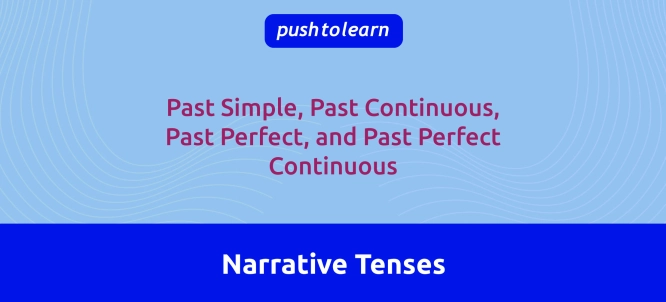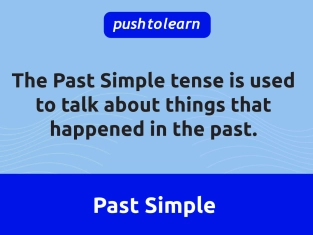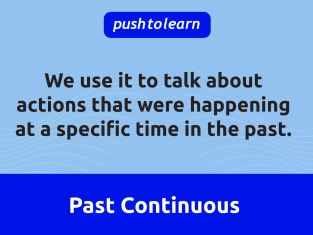by PushtoLearn
Narrative Tenses – All Past Tenses
Table of Contents
Narrative Tenses – Exercises
These exercises focus on Narrative Tenses
What Are Narrative Tenses?
Narrative tenses help us describe events, background details, and sequences in past stories. For example:
-
"I woke up early (Past Simple) because the sun was shining brightly (Past Continuous)."
They show the order and type of actions in a story.

Overview of Narrative Tenses
|
Tense |
Usage |
Example |
|
Past Simple |
Main events or actions that move the story forward. |
"She entered the room and sat down." |
|
Past Continuous |
Background actions or ongoing events at a specific time in the past. |
"The birds were singing outside." |
|
Past Perfect |
Actions completed before a certain time in the past. |
"She had already left when I arrived." |
|
Past Perfect Continuous |
Actions that were ongoing before another past event. |
"He had been waiting for hours when they arrived." |
The Four Narrative Tenses in Detail
1. Past Simple
Past Simple describes completed actions in the past. These actions often happen in sequence.
Rules:
-
Regular verbs add -ed:
"walk" → "walked" -
Irregular verbs have unique forms:
"go" → "went"
Examples:
-
"I visited Paris last summer."
-
"He finished his homework and went to bed."
Common Errors:
|
Mistake |
Correct Form |
|
"He go to school." |
"He went to school." |
|
"I seed the movie." |
"I saw the movie." |
2. Past Continuous
Past Continuous describes actions that were happening at a specific time in the past or background events.
Rules:
-
Use was/were + verb-ing.
Example: "I was watching TV."
Examples:
-
"The phone rang while I was cooking."
-
"They were playing football when it started raining."
Common Errors:
|
Mistake |
Correct Form |
|
"I was cook dinner." |
"I was cooking dinner." |
|
"They were playing when it rains." |
"They were playing when it rained." |
3. Past Perfect
Past Perfect is used for actions that happened before another action in the past.
Rules:
-
Use had + past participle.
Example: "I had eaten."
Examples:
-
"By the time we arrived, the train had already left."
-
"She had finished her homework before dinner."
Common Errors:
|
Mistake |
Correct Form |
|
"The train left before we arrive." |
"The train had left before we arrived." |
|
"I hadn’t saw him." |
"I hadn’t seen him." |
4. Past Perfect Continuous
Past Perfect Continuous describes longer actions that continued up to a certain point in the past.
Rules:
-
Use had been + verb-ing.
Example: "I had been studying."
Examples:
-
"He had been working for three hours when the meeting started."
-
"She was tired because she had been running."
Common Errors:
|
Mistake |
Correct Form |
|
"I had been work all day." |
"I had been working all day." |
|
"She had being running." |
"She had been running." |
How Narrative Tenses Work Together
When telling a story, you often combine narrative tenses to describe actions and their sequence clearly.
Example Story:
-
Past Simple: "I woke up early and got ready for school."
-
Past Continuous: "The sun was shining, and the birds were singing."
-
Past Perfect: "I realized I had forgotten my homework."
-
Past Perfect Continuous: "I had been studying all night, so I was very tired."
Common Errors When Using Narrative Tenses
|
Error |
Correct Form |
|
"When I arrived, they ate dinner." |
"When I arrived, they were eating dinner." |
|
"She was happy because she finish her work." |
"She was happy because she had finished her work." |
|
"He had been wait for hours." |
"He had been waiting for hours." |
FAQs About Narrative Tenses
What are narrative tenses?
Narrative tenses are past tenses used to tell stories. They include Past Simple, Past Continuous, Past Perfect, and Past Perfect Continuous.
When do I use the Past Simple?
Use the Past Simple for completed actions or events that move the story forward, like: "He opened the door."
How do I know when to use the Past Perfect?
The Past Perfect is used for actions that happened before another action in the past, like: "She had left before I arrived."
Can I mix narrative tenses in one story?
Yes! Mixing tenses makes stories more detailed. For example: "I arrived (Past Simple) while they were having dinner (Past Continuous). They had already eaten (Past Perfect)."
What’s the difference between Past Continuous and Past Perfect Continuous?
-
Past Continuous: Background actions at a specific time (e.g., "I was reading when he called.")
-
Past Perfect Continuous: Actions happening over time before another action (e.g., "I had been reading for two hours before he called.")

